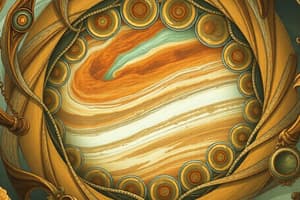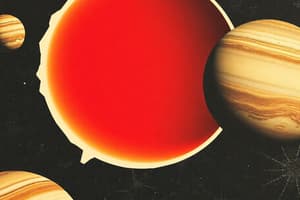Podcast
Questions and Answers
What is significant about Jupiter's Great Red Spot?
What is significant about Jupiter's Great Red Spot?
- It has been observed to change color frequently.
- It is a type of moon that orbits Jupiter.
- It is a storm that has lasted for at least 350 years. (correct)
- It is the largest volcano in our solar system.
Which statement correctly describes Jupiter's atmosphere?
Which statement correctly describes Jupiter's atmosphere?
- It has a thin atmosphere mainly made of carbon dioxide. (correct)
- It contains large amounts of water vapor.
- It is the densest atmosphere of all gas giants.
- It is primarily composed of oxygen and nitrogen.
What is Jupiter's length of a day?
What is Jupiter's length of a day?
- 24.6 hours (correct)
- 12 Earth years
- About 10 hours
- 687 Earth days
Which fact is true regarding Jupiter's size?
Which fact is true regarding Jupiter's size?
What is Mars often referred to as and why?
What is Mars often referred to as and why?
How long does it take Jupiter to complete one orbit around the Sun?
How long does it take Jupiter to complete one orbit around the Sun?
Which of the following accurately describes Jupiter's distance from the Sun?
Which of the following accurately describes Jupiter's distance from the Sun?
Which one of Jupiter's moons is noted for being the most volcanically active?
Which one of Jupiter's moons is noted for being the most volcanically active?
What phenomenon causes Uranus to have a blue color?
What phenomenon causes Uranus to have a blue color?
What is unique about Uranus's rotation compared to its orbit?
What is unique about Uranus's rotation compared to its orbit?
Which spacecraft was the only one to visit Neptune?
Which spacecraft was the only one to visit Neptune?
How long does it take for Neptune to complete one orbit around the Sun?
How long does it take for Neptune to complete one orbit around the Sun?
What are comets considered to be remnants of?
What are comets considered to be remnants of?
Where are comets primarily found before they are redirected toward the Sun?
Where are comets primarily found before they are redirected toward the Sun?
What triggers the formation of a comet's tail?
What triggers the formation of a comet's tail?
What is the term for the closest point in a comet's orbit to the Sun?
What is the term for the closest point in a comet's orbit to the Sun?
Which of the following gases is NOT part of a comet's tail composition?
Which of the following gases is NOT part of a comet's tail composition?
What is the Oort Cloud primarily known for?
What is the Oort Cloud primarily known for?
What is the expected return year for Halley's Comet based on its 76-year orbit?
What is the expected return year for Halley's Comet based on its 76-year orbit?
How often does Comet C/1995 O1 (Hale-Bopp) orbit the Sun?
How often does Comet C/1995 O1 (Hale-Bopp) orbit the Sun?
What forms the coma of a comet?
What forms the coma of a comet?
What are short-period comets primarily associated with?
What are short-period comets primarily associated with?
What is the appearance of the dust tail of a comet?
What is the appearance of the dust tail of a comet?
What characteristic defines the nucleus of a comet?
What characteristic defines the nucleus of a comet?
What are the main types of meteorites?
What are the main types of meteorites?
What are stony meteoroids without chondrules called?
What are stony meteoroids without chondrules called?
How are most meteoroids that cause meteors described in size?
How are most meteoroids that cause meteors described in size?
Why do asteroids have irregular shapes?
Why do asteroids have irregular shapes?
What occurs during a penumbral lunar eclipse?
What occurs during a penumbral lunar eclipse?
What is the primary composition of most meteorites?
What is the primary composition of most meteorites?
What is a significant environmental effect of meteors entering the atmosphere?
What is a significant environmental effect of meteors entering the atmosphere?
What is a common cause of meteor showers?
What is a common cause of meteor showers?
What visual effect occurs during a total lunar eclipse as a result of Earth's atmosphere?
What visual effect occurs during a total lunar eclipse as a result of Earth's atmosphere?
Why do lunar eclipses not occur every month?
Why do lunar eclipses not occur every month?
During which phase does a solar eclipse occur?
During which phase does a solar eclipse occur?
What is a characteristic of a partial lunar eclipse?
What is a characteristic of a partial lunar eclipse?
How often do solar and lunar eclipses repeat their cycles?
How often do solar and lunar eclipses repeat their cycles?
What primarily causes the Moon to become obscured during a solar eclipse?
What primarily causes the Moon to become obscured during a solar eclipse?
In a lunar eclipse, which body is positioned directly opposite the Sun?
In a lunar eclipse, which body is positioned directly opposite the Sun?
Which of the following describes what happens to the Moon during a total lunar eclipse?
Which of the following describes what happens to the Moon during a total lunar eclipse?
Flashcards are hidden until you start studying
Study Notes
JUPITER (GAS PLANET)
- Named after the Roman god Zeus and associated with war due to its reddish hue.
- Diameter: Approximately 6,779 kilometers (4,212 miles) and can contain over 1,000 Earths.
- Distance from the Sun: 228 million kilometers, making it the fifth planet in the solar system.
- Day length: 24.6 hours; Year length: about 687 Earth days.
- Surface temperature ranges from -5°C to -87°C.
- Hosts the Great Red Spot, a massive storm larger than Earth, persisting for over 350 years.
- Atmosphere primarily composed of carbon dioxide (95.3%), nitrogen, and argon.
- Features a system of rings and numerous moons, highlighting its immense size and magnetic field.
MARS (RED PLANET)
- Known as the Red Planet due to its iron-rich soil, giving it a reddish appearance.
- Home to Olympus Mons, the tallest volcano and largest mountain in the solar system, towering 16 miles high.
- Contains the Borealis Basin, the largest crater on Mars, covering 5,300 miles and accounting for 40% of the planet’s surface.
URANUS
- Discovered on March 13, 1781, by William Herschel using a telescope.
- Named after the Greek god of the sky; characterized by a blue hue from methane gas in its atmosphere.
- Rotates on its side, almost at a 90-degree angle from its orbit, in retrograde motion.
- The planet has completed its first orbit in 165 years since discovery (1846).
COMETS
- Composed of ice and dust; known for their long tails formed as they approach the Sun.
- Typically classified as short-period comets found in the Kuiper Belt or long-period comets originating from the Oort Cloud.
- As comets near the Sun, they heat up, causing ice to sublimate into gas, creating visible tails.
- Famous comets include Halley, which will return in 2061, and Hale-Bopp, which was prominent in 1996-1997.
ASTEROIDS
- Vary in size and shape, most being jagged and irregular; they can range from pebbles to hundreds of miles in diameter.
- Classified into three main types: stony, metallic, and stony-metallic.
- Composition primarily includes nickel and iron, with some containing clay or other rock types.
METEORS AND METEOR SHOWERS
- Millions of meteors enter Earth's atmosphere daily, with possible meteor showers occurring when Earth passes comet debris.
- Notable meteorites include Chelyabinsk, Allan Hills 84001, and the Winchcombe meteorite.
LUNAR ECLIPSE
- Occurs when Earth blocks sunlight from reaching the Moon, aligning Sun, Earth, and Moon.
- Types of lunar eclipses: Penumbral (slight dimming), Partial (Earth's shadow partially covers the Moon), and Total (Moon appears red due to filtered sunlight).
- Occurs less frequently than expected due to the Moon’s orbit being tilted by 5 degrees.
SOLAR ECLIPSE
- Occurs when the Moon passes between the Earth and the Sun, casting a shadow over the Earth's surface.
- Only happens during a New Moon, when the moonlit half is turned away from the Earth.
- Eclipses repeat in cycles, occurring approximately every 18 years.
Studying That Suits You
Use AI to generate personalized quizzes and flashcards to suit your learning preferences.




